What are aquatic invasive species?
Aquatic invasive species (AIS) are organisms that are not native and cause significant harm to an ecosystem when introduced. Impacted sectors include municipal water sources, recreation, agriculture, aquaculture, and other commercial activities.
AIS including crustaceans, fish, plants and mollusks are present in Wyoming. New Zealand mudsnails and Asian clams are the most problematic of our current populations. While these species cause problems and need to be managed, the most significant known threat to Wyoming is from zebra and quagga mussels. This is based on their numerous demonstrated negative impacts and proximity to Wyoming.
Wyoming does not currently have any known populations of zebra or quagga mussels.
Zebra/Quagga mussels
Zebra and quagga mussels have the potential to wreak havoc on Wyoming waters. Do your part by making sure to Clean, Drain and Dry your boat and gear. Origin - The Black and Caspian Seas in Eurasia. Distribution - They are widespread throughout the United States, including all neighboring states except Montana. Invasive zebra and quagga mussels have not yet been found in Wyoming, one of only five states in the continental United States without a population. Impacts - They reproduce exponentially and can rapidly infiltrate waters. They remove nutrients and plankton from water, clog pipes and waterways, damage boats and out-compete native species. Dispersal - They are transported in water on boats as microscopic larvae or attached to the hull, motor, or other hard surface of a boat as adults. Adult mussels can live outside of water and larvae can live in stagnant water, both for up to 30 days. Characteristics - Typically striped, they grow up to 2 inches in length. These mussels grow byssal threads, tentacle-like extensions which allow them to attach to hard substances.
New Zealand mudsnail
New Zealand mudsnails are already present in some Wyoming waters but you can stop their spread to other waters by making sure to Clean, Drain and Dry your fishing waders and other gear. Origin - New Zealand. Distribution - Throughout the Western U.S. and Great Lakes. They are present in Wyoming in Yellowstone National Park, Lake Cameahwait, Boysen Reservoir, Alsop Lake, Flaming Gorge Reservoir and in the Bighorn, Shoshone, North Platte, Salt and Snake rivers. Impacts - They are very prolific and can out-compete native snails and can alter water chemistry at high densities. Dispersal - In mud on fishing gear, especially waders. They can also disperse downstream through water currents once established in an area. Characteristics - Light to dark brown, size ~ 0.2 in, elongate shell, 5-6 whorls, operculum visible on live snails.
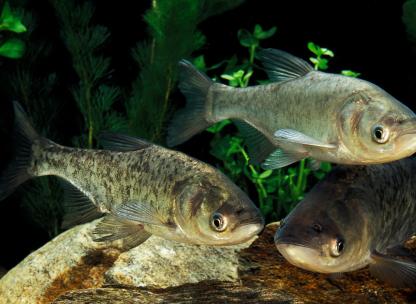
Invasive carp
Also known as Asian carp (including bighead, black and silver carp), these fish have caused substantial harm in other areas of the country. You can make sure they don’t do the same in Wyoming by never moving fish from one water to another by making sure your boat and gear is clean, drained and dry. Origin - Asia and Russia. Distribution - They are widespread throughout the eastern United States, and have recently been found near the Great Lakes. Impacts - They out-compete native fishes, reduce forage for other fish, and can transmit disease. Silver carp are also known for their ability to jump great distances out of the water when boats travel near them, causing injury to boaters. Dispersal - They are transported downstream in water and overland in bait buckets and illegally by people. Characteristics - Large; 39-40 inches and 40-50 lbs., thick bodied with blunt head.
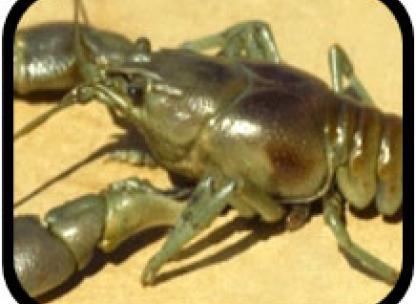
Rusty crayfish
Rusty crayfish were discovered in a tributary to the North Platte River in Wyoming in 2006. Eradication efforts were conducted and no other populations had been found for several years post-treatment. Unfortunately, rusty crayfish were once again detected in this area in 2012. Treatments were conducted in 2012 and 2013 to remove this invasive species from the drainage. Be sure you are not spreading these unwanted animals to Wyoming by making sure your boat and gear is clean, drained and dry. Origin - Eastern United States. Distribution - Found in Laramie River below Wheatland Reservoir #2 to Tunnel Road, Bluegrass and Wagonhound Creeks in Wyoming. They are found throughout the United States, most recently in Colorado. Impacts - These crayfish are voracious and out-compete natives and reduce plant diversity and abundance. Dispersal - They are spread unintentionally through baitfish introduction or by illegal introductions. Characteristics - Rusty spots on carapace, size up to 4 in, large, robust, smooth claws, claws gray-green or red-brown.
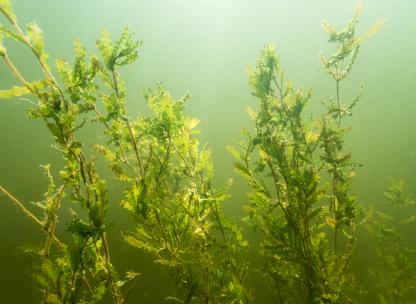
Aquatic plants
Aquatic plants, such as Hydrilla, Eurasian watermilfoil, and Curly Pondweed can have huge impacts on fishing, boating, and even swimming in Wyoming waters. Be sure you are not spreading these unwanted plants to Wyoming by making sure your boat and gear is clean, drained and dry. Origin - Eurasia, Africa and Australia. Distribution - Found in Flaming Gorge Reservoir, Lake DeSmet, Newton Lakes, Beck Lake, Shoshone River. North Platte River (Miracle Mile), and Keyhole, Boysen, Deaver, Wheatland #3 and Pathfinder Reservoirs, Wyoming. Impacts - Competes with native plants reducing plant diversity and forms dense mats that impact water-based recreation. Dispersal - Reproduces by seed which can be easily transferred in mud or water. It has been introduced into new areas by accidental introductions and as an ornamental plant. Characteristics - Leaves are arranged alternately along the stem, and are submersed. The leaf margins are distinctively wavy or 'curled‘ with a prominent red-tinged midvein.
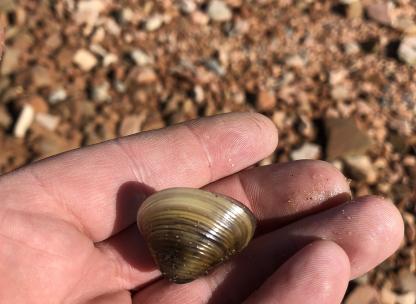
Corbicula
Also known as Asian clams, these bivalves are already present in some eastern Wyoming waters. You can stop their spread to other waters by making sure your watercraft is clean, drained and dry and you do not move organisms in bait buckets or dredges. Origin - Asia, Africa, the Mediterranean, and Australia. Distribution - These clams are believed to have been introduced intentionally as food or incidentally imported with the Pacific oyster. They are found in 47 states. In Wyoming they are present in Glendo and Guernsey Reservoirs and the North Platte River downstream of Glendo Reservoir, the Fort Laramie irrigation canal, the Laramie River below Grayrocks Reservoir, Keyhole Reservoir and Horse Creek. Impacts - They clog pipes at power generation water supply facilities, causing millions of dollars in damage. Dispersal - Through bait bucket introductions, accidental introductions with aquaculture species, illegal introductions for food, and through water currents. Characteristics - Light brown to yellow-green, size ~ 1 in. wide, round/raised concentric rings on the outside of the shell, 3 central cardinal teeth (2 serrated) on inner hinge.
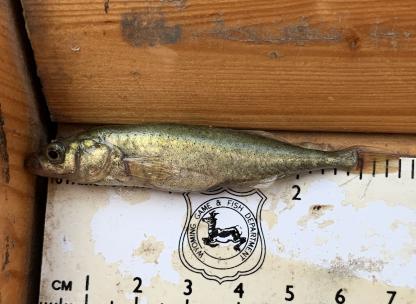
Brook stickleback
Brook stickleback have been introduced to many Wyoming waters. You can prevent further spread by not moving eggs or water between drainages and keeping an eye out for brook stickleback in live batfish. Origin - Central North America. Distribution - Introduced into 18 states outside of its native range. In Wyoming they have been found in several drainages including the Beaver, Badwater, Big Horn Lake, Cach La Poudre, Glendo, Laramie, Lone Tree–Owl, Medicine Bow, North Platte, Pathfinder-Seminoe Reservoir, South Fork Powder and Shoshone drainages. Impacts - They compete with and negatively affect other fish species and waterfowl. Studies show that waterfowl may be negatively impacted by brook stickleback due the species’ affect on zooplankton biomass and abundance. Brook stickleback are known to forage for other fish species’ eggs which may negatively impact fish populations and result in reduced fishing opportunities. Dispersal - Primarily as a result of baitfish introductions, but also through accidental introductions with aquaculture species and through water currents. Characteristics - Adults grow to 2 - 3 inches long, they have small mouths with swollen lips and the bottom lip extends beyond the upper. They have 2 - 7 (usually 5) unconnected spines in front of the dorsal fin.
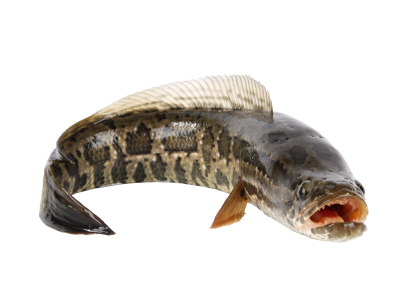
Snakehead
Snakehead are species within two genus groups. They were introduced to the United States as food in Asian markets and as pets, then released into the wild. Do your part to make sure these fish do not make it to Wyoming by not releasing live fish into our waterways. Origin - Southern and eastern Asia and parts of Africa. Distribution - Waters in Arkansas, California, Florida, Delaware, Georgia, Illinois, Maryland, Massachusetts, Missouri, Mississippi, North Carolina, New Jersey, New York, Pennsylvania, and Virginia. Impacts - They are able to adapt to a variety of habitats and can live for long periods of time (up to four days) out of water. Snakehead feed primarily on other fish, but also eat insects, plants, crustaceans, reptiles and even small birds and mammals. There are no known natural predators of snakehead in the U.S. Dispersal - Through intentional or unintentional introduction as fish or their eggs and through water currents. Characteristics - Look similar to a bowfin and burbot. Large mouth with strong jaw and canine-like teeth, dark and irregular blotches along their sides, elongated dorsal and anal fins, pelvic fins located beneath the pectorals, truncated tail.
